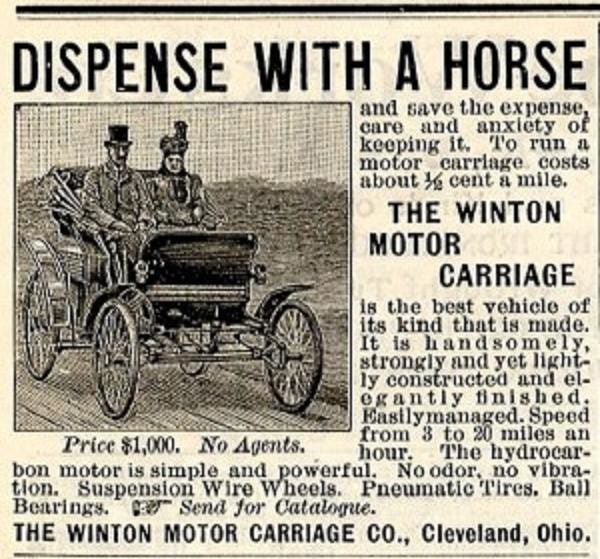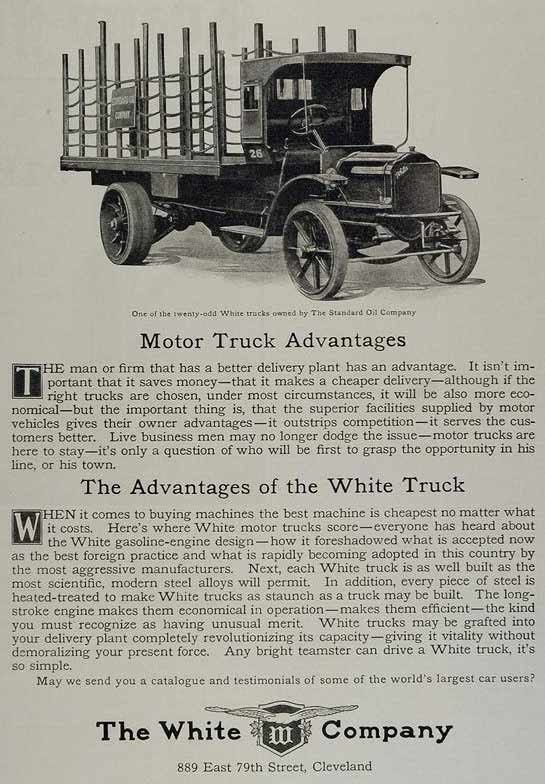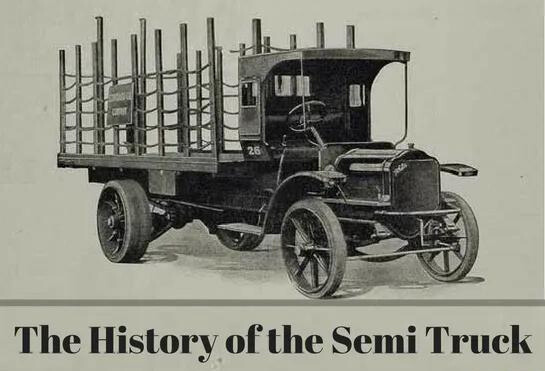The history of the semi truck is fascinating. Aside from electricity, it could be argued that no greater 19th century invention shaped shipping in the United States of America more than the semi truck. Predating airplanes and interstates, semi trucks allowed American farms and businesses to sell beyond their borders in ways that trains simply could not. In fact, semi trucks are still such an integral part of the American economy that they haul over 70% of the goods we consume. So, where did the semi truck come from and how has it kept up with technology to evolve into the dominate force in shipping that it is today?
Prior to the invention of trucks, freight was hauled by horse drawn carriages and trains. Railroads were highly efficient at moving large amounts of cargo but could only deliver those goods to centralized urban centers where train stations were. While this helped grow urban areas, it fundamentally limited the growth of rural areas and even towns located miles away from city centers.
That was until 1896 when Scottish immigrant, Alexander Winton, owner of the Winton Bicycle Company shifted his focus from peddles to engines. He initially experimented with single-cylinder automobile before starting his car company.
In 1897 the Winston Motor Carriage Company was incorporated in Cleveland, Ohio and they launched with a series of handcrafted automobiles. Each vehicle had ornate exteriors, with hand painted sides, as well as padded seats, a leather roof, and gas head lamps. The cars rode on B.F. Goodrich tires.

Winton was a firm believer that auto racing was the way to market his vehicles. So, in May of that year, Winton showed off his 10-horse power model with a race around a Cleveland horse track. There it impressed onlookers after being clocked with a track speed of 33.64 MPH.
Despite the fast track times, critics were still concerned about the practicality of the automobiles. To assuage his doubters, Winton ordered an endurance run that saw his car make the 800 mile drive from Cleveland to New York City.
The marketing worked and just over a year after launching his car company, Winton made his first sale to Robert Allison of Port Carbon, PA. Winton would go on to sell 21 more cars that year at the list price of $1000 (roughly $30,000 in today’s dollars)
By 1899, Winton would sell more than 100 cars, making his company the largest manufacturer of gas powered automobiles in the USA.
However, due to the success of the Winton automobile, the company was faced with a new problem. How to get their car to buyers, some spread out across the country, without adding significant wear and tear to the vehicles by driving them directly to customers. To solve this problem, Winton built the first ever auto hauler. This worked by converting a standard Winton automobile into a tractor and then attaching a trailer to the rear which could pull one car at a time.
In 1903, a Winton Automobile made the first successful drive across the US, as Dr. Horatio Nelson Jackson made the trek from San Francisco to Manhattan in 63 days, 12 hours, and 30 minutes. Since interstate highways didn’t yet exist, this was quite the trip that often saw Jackson and his passenger, a mechanic, driving miles out of their way to get beyond impassable roads and terrain. They even needed to use a series of pulleys, horses, and good old fashion sweet equity to hoist the car over rocks and pull it free from sand.
By 1910, improvements in engines, transmissions, and expanded roadways gave rise to the popularity of shipping via truck. In 1914 there were over 100,000 trucks on America’s roads. At this point, there were so many trucks in operation that 4 states enacted the very first weight limits for semis ranging from 18,000 lbs. to 28,000 lbs. Still, solid tires, a lack of practical trailers, poor rural roads, and a 15 mph speed limit kept trucks confined to short-haul urban routes.
While it was the need to move cars that saw the development of the first semi-truck, it was a rich guy with a boat that had to get to Michigan who’s order for a trailer began production on what would eventually become the modern semi trailer. It was 1914 that Frederic M. Sibley asked August Charles Fruehauf to build a trailer for his Ford Model T that would pull the businessman’s boat. In fact, Sibley was so impressed by Fruehauf’s work that he then commissioned him to make trailers for his lumber yard.
Fruehauf, who was a blacksmith and carriage maker by trade, began the Fruehauf Trailer Company in 1918. Industries like dairy, lumber, and fuel oil took notice of these “go-anywhere” trailers almost immediately. Their original marketing campaign gave birth to the slogan, “A horse can pull more than it can carry, so can a truck.” Fruehauf trailers would eventually see action in World War I, World War II, and the Korean War. During this period of extreme success, the company would hold over 150 military patents.
Like most industrial technologies, a war time need rapidly aided in the development of long-haul trucking. Congestion on the railroads highlighted the need for alternative modes of transportation to move cargo. During the war years of 1914-18, Roy Chapin began work on the development of long distance trucking shipments. Chapin soon realized that trucks could travel much further on inflatable tires as opposed to the solid ones that trucks currently used.

Concurrently, two truck manufacturers would rise to prominence by 1920, White Motor Company and Mack Trucks. By the start of 20’s there were over a million trucks on America’s roadways.
Through the next decade, a number of improvements would go a longways in increasing the proliferation of the truck. Diesel engines increased fuel efficiency by 25–40% over gasoline engines, truck and trailer sizes started adhering to standards, and power assisted steering and brakes were developed. By 1933, trucks would become so common that all states had some form of truck weight regulation.
Trucking would undergo a number of refinements and changes in the ensuing years, but none were as impactful to the history of the semi truck as what would in occur in 1956. The Federal Highway Act of 1956 was the first step in connecting the country. Enacted by President Eisenhower, the bill authorized $25 billion (roughly $232 billion in today’s money) for the construction of over 40,000 miles of interstate highway over a 10-year period. It was the largest public works project in American history up until that time. The act also included the first set of federal maximum gross vehicle limits for trucks, which capped at 73,280 lbs.
Just as the Federal Highway Act was breaking ground on America’s freeway system, Malcom McLean introduced his revolutionary new shipping container. This standardized metal box would change the way modern containerized intermodal shipping would be handled from then on. It allowed trucks, trains, and ships to all use similar equipment for transporting the same loads. This dramatically increased efficiencies and allowed for fluid transfer between multiple modes of transportation.
It wouldn’t be until the 1970’s, when trucking hit Hollywood, that life behind the wheel of a big rig became synonymous with cool. With over 18 million trucks on the road, Americans took notice and gave rise to trucker culture. Seen as lone wolf outlaws, renegades, and free birds, truckers found their niche amongst an interested public. Movies like ‘Smokey and the Bandit’ and songs like ‘Convey’ rose to the top of the box office and Billboard charts. Even CB radio slang became popular enough to find its way into everyday conversation.
Unfortunately, by the end of the decade things would change. The 1979 energy crisis availed the favor that truckers had just received from a once endearing public. A series of violent protests and strikes, as well as changing cultural dynamics would push the mainstream perception of truckers back into the shadows.
The Motor Carrier Act of 1980 deregulated the trucking industry and opened the floodgates for the number of companies that could operate as carriers. This, along with rapid de-unionization, ultimately hurt driver pay. The public spotlight moved on, and truckers were now relegated to horror movies where they’re portrayed as sociopathic, road-raging, highway stalkers.
By this point, trailers had undergone their own evolution. This was due to the use of standardized shipping pallets. The typical North American grocer’s pallet is 48 inches long by 40 inches wide. As trailers grew in size they would often do so at multiples of 4 feet. For a long time, the 48-foot dry van was the de facto standard in shipping due to regulation which limited overall vehicle length to 75 feet. Once those regulations were changed, the industry adopted the 53-foot trailer. These have room for 13 rows of pallets, plus and extra foot so that the door will close.
Last year the ELD mandate went into effect causing an industry wide uproar. This has spurred new debate over mandatory break times and hours of service regulations. In addition, the new regulations have changed the way carriers conduct their business. Shippers who delay drivers with significant dwell times are struggling to find decent rates and capacity as the industry adjusts to new demands. Shipper of choice has become the buzz term for what carriers think shippers should aspire to be.
In 2017 trucking accounted for $719 billion in total revenue, across 15.5 million trucks, which transported 71% of all US goods. By 2018, trucking shipments were outpacing the number of available trucks as the US faces a capacity crisis fueled by a nationwide driver shortage.
Over the next decade trucking revenue is projected to hit $1.25 trillion. In the 2020’s we’re likely to see wide spread use of new technologies like platooning, autonomous trucks, and digital freight matching services as cargo gets uberized. As the history of the semi truck continues to be written, the next chapter in this industry changing saga could be its most exciting one yet.
We’ll leave you with some facts & figures:
- There are just under 3.5 million truck drivers in the United States.
- Trailers are typically 53 feet long
- One-third of all of the semi trucks operating in the U.S. are registered in California, Florida, and Texas.
- $41.3 billion the amount paid by commercial trucks in federal and state highway-user taxes in 2015.
- 450.4 billion total miles traveled by all registered trucks in 2015. To put that into perspective: the sun is 93 million miles away. That’s a round trip to the sun and back more than 2,421 times!
- Trucks get roughly 7.2 MPG
- The maximum weight for a U.S. semi truck and full trailer is 80,000 pounds spread over 18 conventional wheels.
- How much power does it take to move a fully loaded semi and trailer? A Detroit Diesel DD15 14.8-liter inline six-cylinder engine weighs 2880 pounds, or 345 pounds more than a Mini Cooper. This colossal powerplant makes up to 560 hp and 1850 lb-ft of torque.
- The top-selling brand of semi truck is Freightliner. Freightliner is owned by Daimler Trucks North America, which also owns the Western Star brand. Second most popular is Navistar International, followed by PACCAR, which owns the Peterbilt and Kenworth brands. Fourth is Volvo, which also owns the Mack brand.
- Antilock brakes on semi trucks have been required since 1997, which has significantly reduced the number of jackknife crashes, in which the rear wheels of the truck lock up and the trailer swings around to an acute angle with the truck. Today the most dangerous semi accidents are rollovers.
LTL Negotiations White Paper
Download our LTL NegoTIATIONS WHITE PAPER today
The goal of any Less-Than-Truckload (LTL) negotiation is to source carriers that will provide great service to your freight, your facilities, your customers, and your suppliers at a fair market price.
However, shippers typically run into trouble when negotiating because they lack the information on how it operates.
To help, we’ve created a white paper on the best practices our experts have accumulated over our 30 years in logistics.
In this guide you will learn:
- The carriers’ operations and needs
- The freight data to collect
- Tips and tricks for negotiating
SIGN UP TO RECEIVE LTL NEGOTIATIONS WHITE PAPER



